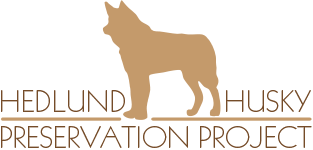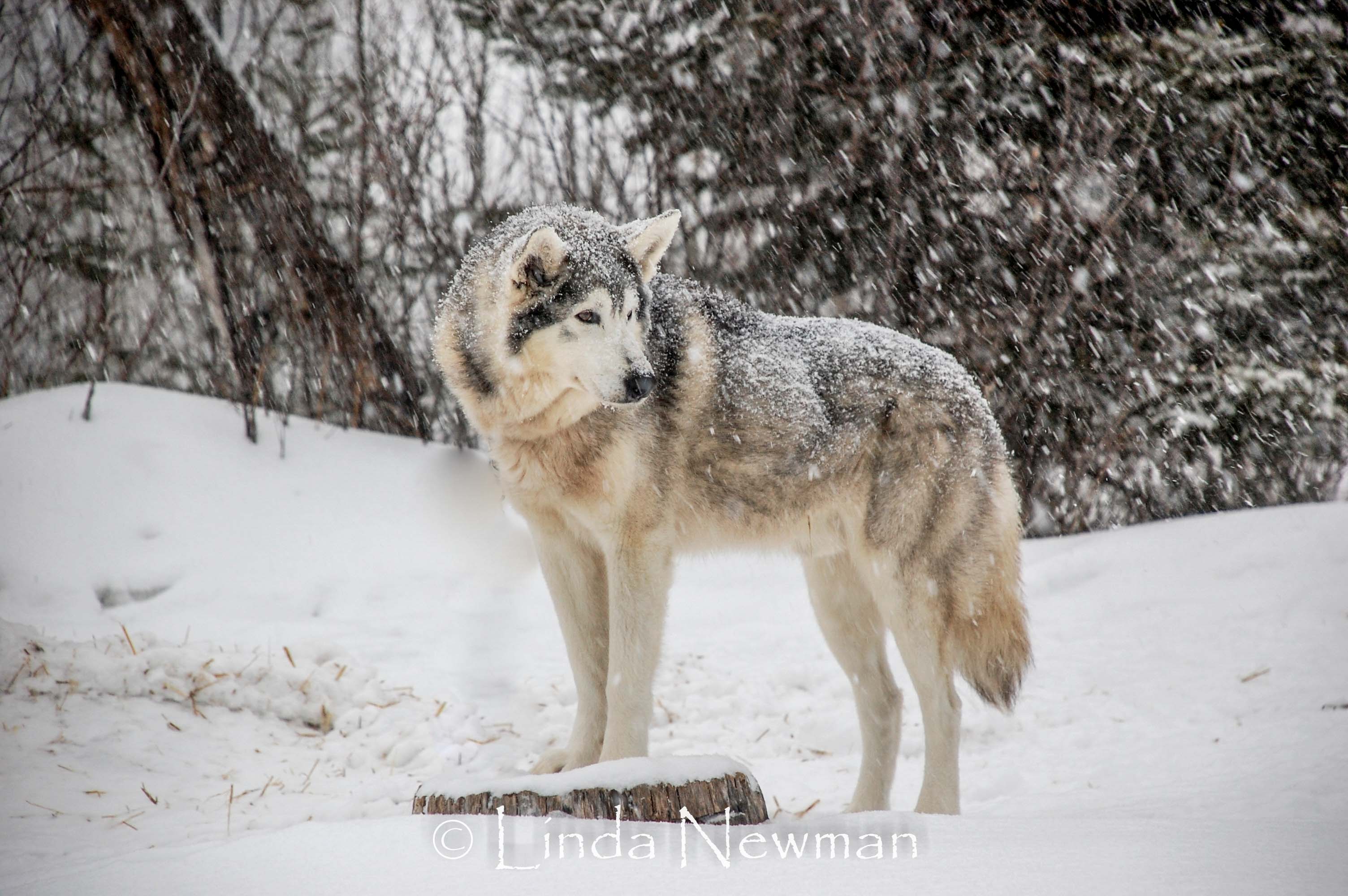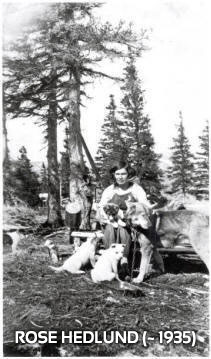Hedlund Husky Standards
General Description
Most modern Hedlund Husky owners consider their dogs to be 'working pets' and as such are very versatile. Hedlund Huskies can be active house pet companions, freight style sled dogs, recreational racing sled dogs or any combination. In appearance, the Hedlund Husky is obviously a working dog that reflects its history as a versatile, indigenously bred working sled dog of the type commonly referred to as a "village dog".
The Hedlund Husky is a medium to medium large working dog with a rangy build, quick and light on its feet and effortless in action. The ideal Hedlund Husky appears to be a well-conditioned athlete with a physical and mental toughness reflecting the climate in which the breed was developed. The Hedlund Husky also offers an appearance of great wisdom and competence that reflects its ancestral development.
Temperament
When introduced to strangers, the adult Hedlund Husky may range from reserved to bold, but is never aggressive toward humans or other dogs. The dog may seek guidance from his/her owner, but reserves the right to make his or her own decision.
The Hedlund husky can be slow to develop a bond with new humans, but once the bond is created s/he is intensely loyal. With familiar people, the Hedlund Husky is bold, playful and enthusiastic. Working Hedlund Huskies are very cooperative, easy to manage and eager-to-please their mushers. Hedlund huskies possess the full range of canine 'body language' and their communications are very clear to those trained to recognize them. The quintessential Hedlund Husky gives the impression of being an animal possessing great wisdom and an ‘old soul.’ While this trait is exceedingly difficult to define, when experienced it is impossible to deny.
The Hedlund Husky is among the most versatile of sled dogs, and copes with changing circumstances and demands well. The Hedlund Husky is equally comfortable and content living in his or her owner’s home, in a kennel with numerous other dogs, or camped alongside a wilderness trail.
Hedlund Huskies display affection toward, and seek affection from humans with whom they have bonded, but are rarely clingy or needy. They are highly intelligent, especially in regards to problem solving. This makes them excellent escape artists, yet they are not inclined to wander far from an owner with whom they've established a bond. Although Hedlund Huskies can be vocal when very excited and will participate in kennel-wide “howls”, they are usually not prone to nuisance barking.
Development
Hedlund Huskies develop physically at about the same rate as other medium to medium large sled dog breeds and can be trained to harness at a young age so long as the musher is careful to avoid overworking very young dogs. They should not be expected or asked to do more than short runs of fewer than three miles in length pulling no excess weight until 12 months of age to avoid injury to rapidly growing bones and joints. Young Hedlund Huskies may appear rather gangly as they learn to coordinate their rangy bodies. By 18 months of age Hedlund Huskies are physically mature enough to perform the full range of sled dog duties, but males continue to grow in physical, sexual and psychological maturity later than do females.
Size, Proportion and Substance
Height ranges between 24” – 28” at the shoulder for bitches and 28” to 31” for males. Weight - Dogs 60 to 80lbs and bitches 50 to 65lbs. Weight is in proportion to height. Most Hedlund Huskies are of a body type that mushers describe as “rangy”, being rather long-legged and long coupled.
Head
Expression is keen and interested and seems to reflect an uncanny depth of intelligence and wisdom. Eyes may be brown, amber or blue in color, with brown and amber being most common. Ears are pricked, held fully erect when interested, and are well furred. The skull is of medium size and proportional to the body, slightly rounded on top and tapering from the widest point to the eyes. The stop is well defined and the bridge of the nose is straight from the stop to the tip. The muzzle is of medium length, tapering gradually to the nose, with the tip neither overly pointed nor squared.
Neck, Top Line and Body
The Hedlund husky's neck is of medium length and slightly arched when standing. While working the neck is extended so that the head is carried slightly forward. Many Hedlund Gray Huskies have a noticeable mane of thick fur.
The chest is deep and strong, but not overly broad with the deepest point being about the level of, and slightly behind, the elbows. The ribs are well sprung but flattened at the sides to allow full freedom of motion. The back is straight and strong with a level top line from the withers to the croup. The loin is taught and lean, narrower than the rib cage with a visible tuck up. The croup slopes away from the spine at an angle but never so much as to restrict the rearward thrust of the hind legs.
Tail
The tail is well furred, and a "fox brush" shape is not uncommon. The tail is set just below the level of the top line and may curve over the back when the dog is alert. While working, the tail is carried in a relaxed, natural arc below the level of the top line.
Forequarters
The shoulder blades are well separated, allowing for full forward extension while working. Front legs should be parallel and strait to the pasterns, which are strong and sturdy but flexible with some spring for proper let-down of feet. Hedlund Huskies are noted for being somewhat long legged and 'rangy' in appearance, for breaking trail in relatively deep snow conditions. Their feet tend to be larger than those on most husky types of dogs, but are not splayed. The feet are well furred and somewhat rounded, reflecting their indigenous ancestry.
Hindquarters
When standing and viewed from the rear, the hind legs are moderately spaced and parallel. The upper thighs are well muscled and powerful, the stifles well bent, the hock joint well-defined and set low to the ground.
Coat
The Hedlund Husky has a double-coat with a thick, downy undercoat well protected by guard hairs, which are straight and somewhat smooth lying. Most Hedlund Huskies have a noticeable furry mane. The absence of an undercoat during the shedding season is normal.
Color
The most frequent base color is an ancestral gray but coloration can incorporate the entire ancestral canid spectrum. Black points are common but a coat that is primarily black in color is not a common trait among Hedlund Huskies. White and a light shade of reddish white are relatively common in Hedlund Huskies. Many have masks and points in contrasting shades of color.
Gait
The working gait of a fully mature adult Hedlund Husky is a fluid seemingly effortless trot, though some individuals may prefer to pace. They have a swagger about them. The gate of young Hedlund Huskies or those with a very rangy build may appear athletically rough though performance and stamina do not seem to be impacted. When in a pace, the Hedlund Husky has a level top line and is therefore very efficient with no wasted energy. A change of gait from a trot to a pace indicates an effective form of energy conservation for the Hedlund Husky. The hindquarters exhibit a strong rear drive. The forequarters receive the drive with a smooth, reaching stride. When viewed from the rear the legs move in line on a track that narrows as the speed increases to nearly a single track.
When working over difficult terrain the Hedlund exhibits a head down, tail low profile driving primarily with the rear legs in a posture that old time mushers referred to as "belly on the snow".


